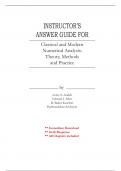INSTRUCTOR’S
ANSWER GUIDE FOR
Classical and Modern
Numerical Analysis:
Theory, Methods
and Practice
by
Azmy S. Ackleh
Edward J. Allen
R. Baker Kearfott
Padmanabhan Seshaiyer
** Immediate Download
** Swift Response
** All Chapters included
, Instructor’s Answer Guide
for
Classical and Modern Numerical Analysis:
Theory, Methods, and Practice
Azmy S. Ackleh, University of Louisiana at Lafayette
Edward J. Allen, Texas Tech University
R. Baker Kearfott, University of Louisiana at Lafayette
Padmanabhan Seshaiyer, George Mason University
January 4, 2010
Contents
Acknowledgments 2
Chapter 1 3
Chapter 2 16
Chapter 3 35
Chapter 4 58
Chapter 5 81
Chapter 6 91
Chapter 7 101
Chapter 8 122
Chapter 9 144
Chapter 10 155
1
,Chapter 1
1. (a) Let f (x) = ex , for x ∈ (−∞, 0]. We have f ∈ C 1 (−∞, 0] and, by
assumption, y ∈ (−∞, 0] with y ≤ x. We may therefore use the Mean
Value Theorem to obtain that there exists a ζ ∈ [y, x] ⊆ (−∞, 0], such
that f (x) − f (y) = eζ (x − y). Hence,
|ex − ey | = |eζ ||x − y| ≤ |e0 ||x − y| = |x − y|, ∀x, y ≤ 0.
(b) Let f (x) = xp , for x ≥ 0, and p ≥ 1. Then, f ∈ C 1 [0, ∞). Suppose
0 ≤ y ≤ x, The Mean Value Theorem then implies ∃ζ ∈ [y, x] ⊆
[0, ∞) such that
f (x) − f (y) = f (ζ)(x − y).
Since g(x) = xp−1 for x ≥ 0 and p ≥ 1 is an increasing function, we
have y p−1 ≤ ζ p−1 ≤ xp−1 . Thus,
py p−1 ≤ xp − y p ≤ pxp−1 (x − y)
for 0 ≤ y ≤ x and p ≥ 1.
(c) The solution is already available in the Appendix of the book.
(d) Since f ′ (x) 6= 0, ∀x ∈ (a, b), either f ′ (x) < 0 or f ′ (x) > 0, ∀x ∈ (a, b).
Since f ′ ∈ C[a, b], f is a continuous monotone function on [a, b].
Thus, f (x) can vanish at most one point in [a, b].
2. An answer is
x2 x4 x6
p(x) = 1 −
+ − .
3! 5! 7!
To see why, observe that, when x 6= 0, Taylor’s Theorem gives
x3 x5 x7 ξ9
sin(x) x− + − +
sinc(x) = = 3! 5! 7! 9! ,
x x
where ξ is between 0 and x. Thus,
ξ8
|sinc(x) − p(x)| ≤ .
9!
Then, −0.2 ≤ x ≤ 0.2 implies
ξ8 (0.2)8
≤ = 7.05 × 10−12 .
9! 9!
3. By Taylors Theorem,
Z x+h
h2 ′′ 1
f (x + h) = f (x) + hf ′ (x) + f (x) + (x + h − t)2 f ′′′ (t)dt,
2! 2! x
Z x−h
h2 1
f (x − h) = f (x) − hf ′ (x) + f ′′ (x) + (x − h − t)2 f ′′′ (t)dt.
2! 2! x
3
, Subtracting the second equation from the first, dividing by 2h, and sim-
plifying then gives
f (x+h)−f (x−h)
2h − f ′′ (x)
Z x+h Z x−h
1 2 ′′′
= (x + h − t) f (t)dt − (x − h − t)2 f ′′′ (t)dt
4h x x
1
≤ max |f ′′′ (t)|
4h x−h≤t≤x+h
Z x−h Z x−h
· (x − h − t)2 dt + (x − h − t)2 dt
x x
� 3
�
1 2h
= max |f ′′′ (t)| · = ch2 ,
4h x−h≤t≤x+h 3
1
where c = max |f ′′′ (t)|.
6 x−h≤t≤x+h
4. This is similar to Problem 3. By Taylor’s Theorem, since f has a contin-
uous fourth derivative, we have
h2 ′′ h3
f (x + h) = f (x) + hf ′ (x) + f (x) + f ′′′ (x)
2! 3!
Z
1 x+h
+ (x + h − t)3 f (4) (t)dt,
3! x
h2 (−h)3 ′′′
f (x − h) = f (x) + (−h)f ′ (x) + f ′′ (x) + f (x)
2! 3!
Z x−h
1
+ (x − h − t)3 f (4) (t)dt.
3! x
Combining these two equations according to the difference quotient gives
f (x + h) − 2f (x) + f (x − h)
− f ′′ (x)
h2
Z x+h Z x−h
1
= 2 (x + h − t)3 f (4) (t)dt + (x − h − t)3 f (4) (t)dt .
6h x x
4




